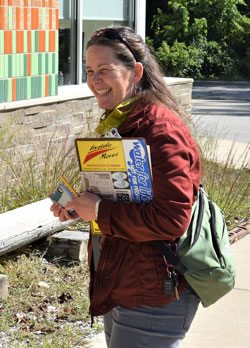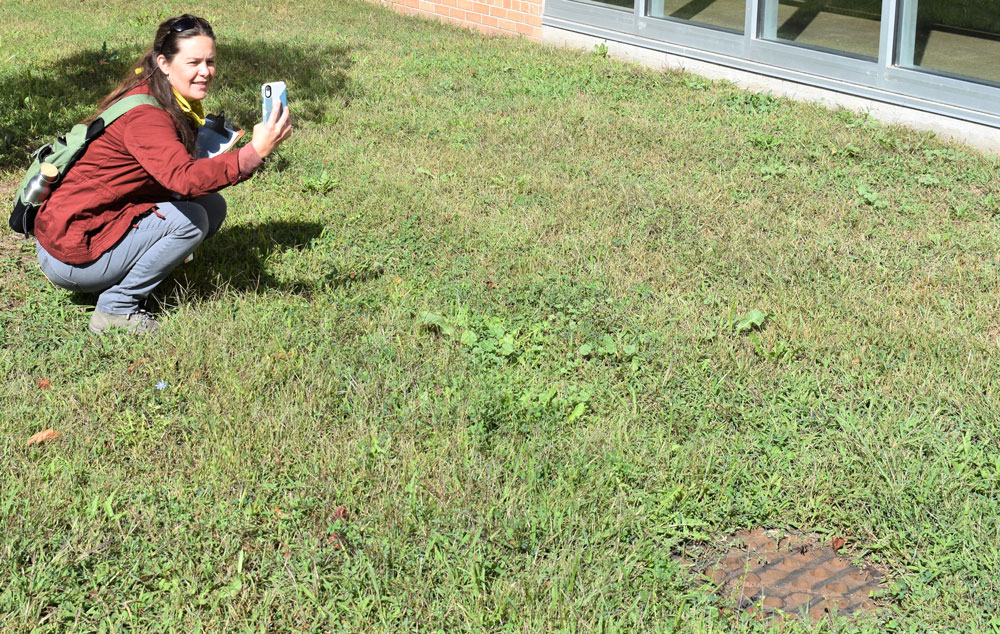Grand Rapids – To walk a school yard with a clipboard-toting Sally Triant is to suddenly see things that could easily be missed.
A recent trip around the grounds of C.A. Frost Environmental Science Academy Middle High School provided ample evidence of her keen eye.
“Okay, good,” she said as she looked at the front of the building, just to the west of the main entrance, and pulled out her phone to take pictures. “We’ve got a roof drain here and a spigot for water. Could be some possibilities here for native plants.”
As she proceeded clockwise around the building, other seemingly innocuous sights caught her eye and warranted pictures and notes.
“Oh, wow, this is interesting,” she said as she looked down at some sparse grass between a sidewalk and parking lot. “Looks like some tire tracks here and some erosion. This could be a great no-mow zone.”
And so it went at every step of the way. Exclamations of excitement, copious photos, more notes. Rinse. Repeat.
Triant is the founder of Grow Wise Learning, and her dream for the organization was to create nature-based curricula for all ages.
She was recently hired by GRPS through grant funding as an Environmental Education Consultant, a position funded through June 2021. Her job includes a lot of connection-making between GRPS and local organizations such as the Grand Rapids Environmental Education Network (GREEN) and the Grand Rapids City Parks Department. It also includes an emphasis on the use of park spaces as outdoor learning environments.

Taking Outdoor Inventories
Her inventory of C.A. Frost was one of 43 Schoolyard Features Inventories that she is doing, to give every GRPS campus a sense of the possibilities it might hold for outdoor education. It’s a big project with each inventory taking close to two hours. She hoped to be done by the end of October.
When the project is complete, every GRPS campus will have a lengthy and detailed report, replete with photos, on what opportunities exist to take learning outdoors.
Triant commended GRPS for its forward-thinking approach to outdoor education. That includes looking at the entirety of the district and its campuses “through the lens of the land that they steward and the potential their property has to promote environmental stewardship in education.”
For Triant, the experience this fall has been a little surreal since GRPS schools began the year with online learning only. Still, she said, it’s a thrill to explore school yards for the first time.
“I am always curious to see the potential that each campus holds, and inspired by the existing efforts,” said Triant, who has a bachelor of science degree and a master’s in education from Grand Valley State University.

Inventories Informed by Survey
Prior to beginning the project, a survey was sent to GRPS staff to understand what opportunities might already exist at schools and where there might be places for new outdoor education. Triant said the survey shows many educators believe environmental education is important, but that lack of outdoor classrooms is a barrier.
‘I am always curious to see the potential that each campus holds.’
— Sally Triant, GRPS outdoor education consultant
The Schoolyard Features Inventory aims to uncover areas in each schoolyard that could potentially serve as outdoor classrooms, and to encourage teachers to use these spaces to connect lessons to their local environment. Guiding questions include:
- Are there any green features present in the schoolyard?
- Could this location serve as a site for a Monarch Waystation and a resource for citizen science?
- Is there evidence of community engagement in the schoolyard?
- Does this site have areas that are mowed but do not need to be, and could become “no-mow” spaces to save resources?
- Is there a garden available for teaching purposes?

Little Spaces, Big Opportunities
For Triant, a master gardener and master naturalist, little spaces often present big opportunities.
So, at C.A. Frost, a parking sign in the middle of a patch of grass becomes a place to perhaps see things differently. While providing necessary information to visitors, she said, “students might identify the fact that the sign is taking up space in a place that is perfectly aligned to become a pollinator garden.”
“Perhaps the sign could be moved, and the intended area could be thoughtfully landscaped to become a habitat or citizen science project,” she added. “All of the elements exist – including access to water – they just need to be identified and acted upon.”
Sometimes, Triant, added, the world’s environmental issues can seem overwhelming. Things like plastics pollution and climate change can appear insurmountable, especially to K-12 students. Small steps close to home, however, can be invaluable.
“This is how we will grow students who become stewards of this Earth that we share,” she said.









